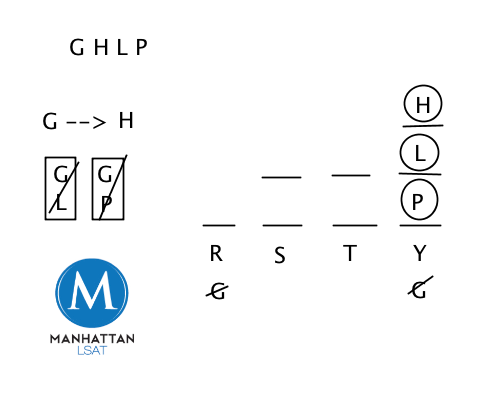LSAT Forum
4 postsPage 1 of 1
-

- aebq196234
-
Thanks Received: 2
- Forum Guests
- Posts: 13
- Joined: August 01st, 2012
Diagram
i am stuck . i tried in the closed diagram and it seemed harder for me. open i came up with HLP have Y and that G can't have Y or R. can someone please put up a diagram.
-

- ManhattanPrepLSAT1
-
Thanks Received: 1909
-
Atticus Finch

- Posts: 2851
- Joined: October 07th, 2009
- This post thanked 1 time.
Re: Diagram
Here you go!


-

- hollandsbanks
-
Thanks Received: 0
- Forum Guests
- Posts: 1
- Joined: February 08th, 2013
Re: Diagram
Hi there,
I'm still not understanding why the languages are the best choice for the base? I see that there are set numbers for each which I guess makes them a more stable/reliable choice for a base, but I know I've practiced games where, even though we new the amount of numbers for the placed variables, we still used the variable recipients as the base.
Is the determining factor just the fact that they gave the definite number for each being learned? I think I'm thinking back to the Repairs Facility game. Any help would be so greatly appreciated!
I'm still not understanding why the languages are the best choice for the base? I see that there are set numbers for each which I guess makes them a more stable/reliable choice for a base, but I know I've practiced games where, even though we new the amount of numbers for the placed variables, we still used the variable recipients as the base.
Is the determining factor just the fact that they gave the definite number for each being learned? I think I'm thinking back to the Repairs Facility game. Any help would be so greatly appreciated!
-

- alex.cheng.2012
-
Thanks Received: 8
- Forum Guests
- Posts: 28
- Joined: May 02nd, 2013
Re: Diagram
Hmm, I'm not entirely sure why using the languages as the base is a better idea (I actually think I tried using both before). However, I did my diagram a lot differently.
G X _ _ X
H _ _ _ ✓
L _ _ _ ✓
P _ _ _ ✓
--R S T Y
--✓✓✓✓
--X ✓✓✓
--X X X ✓
--X X X X
The check mark means that person learned the language. The X means they don't. So H learns Y, and G doesn't learn Y. (There's a -- before RSTY only to align the elements when posting on the forum. On paper, I of course did not do this).
You can go ahead and tackle the questions from here. I chose to frame it, and ended up with three diagrams.
I split it along G. We know G has to learn at least one language, and can possibly learn two. So one diagram has G learning only S, one diagram has G learning only T, and the last diagram has G learning S and T. Admittedly, the only diagram you can complete (or near-complete) is when G learns S and T, but the other two diagrams are still helpful and helped me out with several questions (most notably question 7).
EDIT: I must add though, that I still took quite some time doing this question, around 10 minutes. There are 7 questions though. I didn't complete the entire game section in one go, so perhaps my strategy would be too time consuming for the entire logic game section. What is the acceptable time to finish this game by?
G X _ _ X
H _ _ _ ✓
L _ _ _ ✓
P _ _ _ ✓
--R S T Y
--✓✓✓✓
--X ✓✓✓
--X X X ✓
--X X X X
The check mark means that person learned the language. The X means they don't. So H learns Y, and G doesn't learn Y. (There's a -- before RSTY only to align the elements when posting on the forum. On paper, I of course did not do this).
You can go ahead and tackle the questions from here. I chose to frame it, and ended up with three diagrams.
I split it along G. We know G has to learn at least one language, and can possibly learn two. So one diagram has G learning only S, one diagram has G learning only T, and the last diagram has G learning S and T. Admittedly, the only diagram you can complete (or near-complete) is when G learns S and T, but the other two diagrams are still helpful and helped me out with several questions (most notably question 7).
EDIT: I must add though, that I still took quite some time doing this question, around 10 minutes. There are 7 questions though. I didn't complete the entire game section in one go, so perhaps my strategy would be too time consuming for the entire logic game section. What is the acceptable time to finish this game by?
4 posts Page 1 of 1